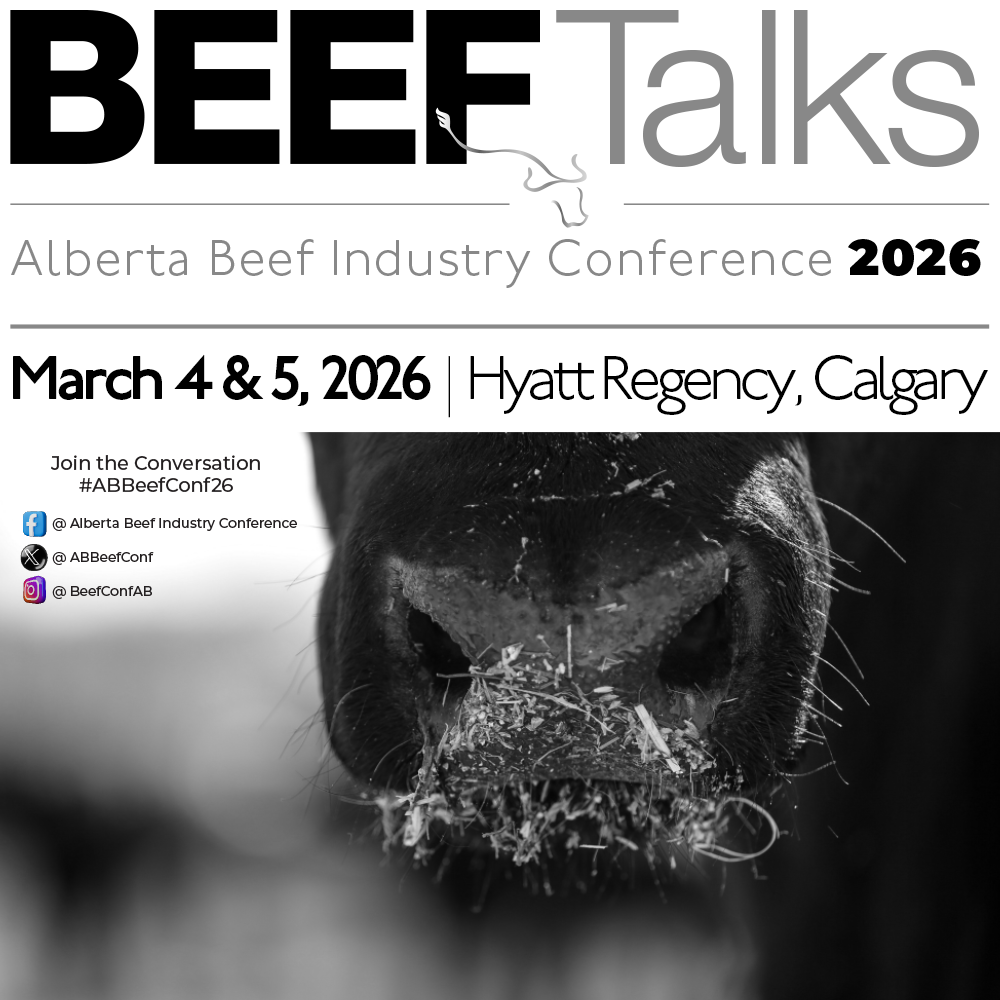AB Direct - Steers
Rail: 492.00-493.50 FOB feedlot (last week)
AB Direct - Heifers
Rail: 492.00-493.50 FOB feedlot (last week)
US Trade- Steers
Rail: 355.00-363.00 (IA, NE) last week
US Trade - Heifers
Rail: 355.00-363.00 (IA, NE) last week
Canadian Dollar
0.19

Building the best beef team
The beef industry is changing.
Cattle are forward contracted at a historic volume; consolidation is rampant and foreign ownership is threading itself throughout the industry. Identity and certified programs capture much of the market through to slaughter, while feeder cattle continue to swap countries just as readily as they do provincial borders.
Export markets demand renowned Canadian genetics and world-class technology, which industry partners are delivering. In the background is the natural environment in which this all happens. The tidy farms, clean air, pristine mountain ranges, pure water, fertile soils and grasslands all are part of the value in marketing the final product – beef.
Farmers, ranchers and cattle feeders know that to be successful they must be supported by professional teams. Veterinarians, nutritionists, forage specialists, IT folks, health crews, accountants, researchers, risk managers and legal advisors are some of the most engaged in the beef cattle community. As we look to the future and the change within the industry, different teams may be necessary.
The cow calf sector has historically taken the bid price that was established through fed cattle markets and the related cost of gain. Traditionally, the focus for the cow calf producer has been on low-cost production and the health and welfare of the animal. Price was not a controllable factor. However, there is potential in looking at marketing with a sharper lens, remembering that both the calf and the data that accompany it have value and are the owners’ property until both the animal and data are transferred. Selling a $1,200 feeder steer may seem good enough, but it is short of the inflationary costs of production and does not reflect the upside potential when coupled with relationship selling for quality attributes, employing risk mitigation strategies or retained ownership.
Retained ownership is not without risk, especially at the current cost of gain. Some producers have turned to retaining a percentage of their herd to market as fed cattle directly to consumers. Appreciating the worth of beef cuts and the potential in value adding can move the mark from mainstream pricing to higher end offerings. Markets are diverse and buyer centric. Consulting with a marketing expert, exploring the range in cultural demand, and adding value with spice/smoke/age/flavour or pre-cooking are all viable options.
The current-day non-negotiable product attributes are climate and environment. Throughout the beef industry, staying ahead of the regulations is just one aspect. The rest of the game is in developing and measuring benchmarks and protocols and then reporting for an evidence-based evaluation of success. Having a designated person on the team or bringing in expertise is critical as we transcend into an era of beef production wherein the future lies in our environmental behaviour as much as it does in genetics or feeding.
Tracking all this action takes a systems approach based on digital technology. Without systems in place and teams to interpret the data, the actions are not measurable nor do they accurately calculate the cost benefit.
Some benefits are immediate and impressive, such as extending grazing seasons with the use of techniques and forage mixes or the application of genomics in genetic selection. Knowing about how the rest of industry works is also imperative and failing to do so can be restrictive. For example, the uncontested move by packers from rail grade to live bids on fed cattle before the development of value-based carcass pricing, cost the fed cattle industry dearly and directly impacted feeder cattle value.
What could come next?
Regardless of the size of the operation there is room for an advisory board or mentors. Calling in those who are visionary allows us to see the possible. Collective voices who have an area of expertise mirror a live research project, bringing evidence to the table.
The sole market for the final beef product is the consumer. Including a young urban consumer in the discussion is really important. They are both interested and invested in information about food production systems and environment, food quality and nutrition. Inviting mentors, financial experts, regulatory and export advisors, investors, meat buyers, environmental specialists, risk mitigators, risk managers, human resources, youth (Gen Z), marketing and herd health experts, researchers and wealth advisors is encouraged. With technology these sessions can be from the comfort of home or office.
Inviting diverse thought to your team and carefully evaluating and measuring results will promote a clearer view of your potential participation up and down the beef chain. Even if there is only one good recommendation, what if it was the game changer for your cow calf herd, feeding program, marketing, risk strategy, beef product development goal, technology upgrade, international exposure or investment partnership?
It takes a team to navigate change. Who is on yours?
This article was first published in Volume 2 Issue 1 of ABP Magazine (January 2022). Watch for more digital content from the magazine on ABP Daily.


